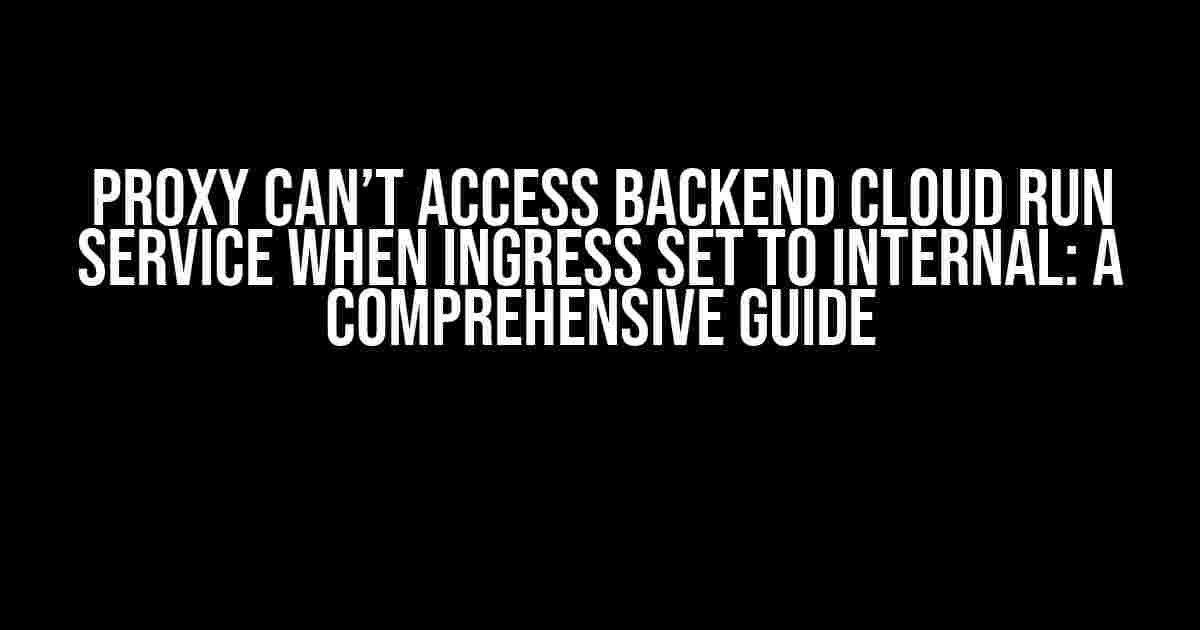Have you ever encountered the frustrating issue where your proxy can’t access your backend Cloud Run service when the ingress is set to internal? You’re not alone! This problem has puzzled many a developer, but fear not, dear reader, for we’re about to embark on a journey to resolve this conundrum once and for all.
Understanding the Problem
Before we dive into the solution, let’s take a step back and understand the issue at hand. When you set the ingress of your Cloud Run service to internal, it means that the service is only accessible from within the same VPC network or from other VPC networks that are peered with it. This is a great security feature, but it can cause problems when you’re trying to access your service from outside the network, such as through a proxy.
The error message you’re likely seeing is something like:
Error: Failed to connect to backend Cloud Run service: dial tcp [INTERNAL_IP]:443: i/o timeout
This error message indicates that the proxy is unable to connect to the backend Cloud Run service because it’s not accessible from outside the network.
The Solution: Using a Service Mesh
One way to solve this problem is to use a service mesh, such as Istio or Google Cloud’s Cloud Mesh. A service mesh acts as a proxy between your proxy and the backend Cloud Run service, allowing you to access the service from outside the network.
Step 1: Enable Istio on Your GKE Cluster
First, you need to enable Istio on your Google Kubernetes Engine (GKE) cluster. You can do this by running the following command:
gcloud beta container clusters update [CLUSTER_NAME] --enable-istio
Replace [CLUSTER_NAME] with the name of your GKE cluster.
Step 2: Create an Istio Gateway
Next, you need to create an Istio gateway that will act as the entry point for your proxy to access the backend Cloud Run service. Create a YAML file with the following contents:
apiVersion: networking.istio.io/v1alpha3
kind: Gateway
metadata:
name: [GATEWAY_NAME]
spec:
selector:
istio: ingressgateway
servers:
- port:
number: 80
name: http
protocol: HTTP
hosts:
- "*"
Replace [GATEWAY_NAME] with the name of your gateway. Apply the YAML file to your GKE cluster using the following command:
kubectl apply -f [GATEWAY_NAME].yaml
Step 3: Create an Istio Virtual Service
Now, you need to create an Istio virtual service that will route traffic from the gateway to the backend Cloud Run service. Create a YAML file with the following contents:
apiVersion: networking.istio.io/v1alpha3
kind: VirtualService
metadata:
name: [VIRTUAL_SERVICE_NAME]
spec:
hosts:
- "*"
gateways:
- [GATEWAY_NAME]
http:
- route:
- destination:
host: [BACKEND_SERVICE_NAME].run.app
port:
number: 80
Replace [VIRTUAL_SERVICE_NAME] with the name of your virtual service, [GATEWAY_NAME] with the name of your gateway, and [BACKEND_SERVICE_NAME] with the name of your backend Cloud Run service. Apply the YAML file to your GKE cluster using the following command:
kubectl apply -f [VIRTUAL_SERVICE_NAME].yaml
The Solution: Using a Cloud NAT
Another way to solve this problem is to use a Cloud NAT, which allows your proxy to access the backend Cloud Run service from outside the network.
Step 1: Create a Cloud NAT
First, you need to create a Cloud NAT. You can do this by running the following command:
gcloud compute routers create [ROUTER_NAME] --region [REGION]
Replace [ROUTER_NAME] with the name of your router and [REGION] with the region of your Cloud Run service.
Step 2: Create a Cloud NAT Gateway
Next, you need to create a Cloud NAT gateway. Create a YAML file with the following contents:
apiVersion: compute.cnrm.cloud.google.com/v1beta1 kind: NATGateway metadata: name: [NAT_GATEWAY_NAME] spec: router: $(ref.[ROUTER_NAME].selfLink) natIPs: - $(ref.[STATIC_IP_ADDRESS].selfLink)
Replace [NAT_GATEWAY_NAME] with the name of your NAT gateway, [ROUTER_NAME] with the name of your router, and [STATIC_IP_ADDRESS] with the static IP address of your NAT gateway. Apply the YAML file to your GKE cluster using the following command:
kubectl apply -f [NAT_GATEWAY_NAME].yaml
Step 3: Configure Your Proxy
Finally, you need to configure your proxy to use the Cloud NAT gateway. Update your proxy configuration to include the following:
http:
upstream:
backend:
servers:
- [NAT_GATEWAY_IP]:80
Replace [NAT_GATEWAY_IP] with the IP address of your Cloud NAT gateway.
Comparison of Solutions
Now that we’ve explored two solutions to the problem, let’s compare them:
| Solution | Advantages | Disadvantages |
|---|---|---|
| Service Mesh (Istio) |
|
|
| Cloud NAT |
|
|
As you can see, both solutions have their advantages and disadvantages. The service mesh solution provides a more flexible and scalable solution, but requires additional infrastructure and can be complex to set up and manage. The Cloud NAT solution is simpler to set up and manage, but is limited to TCP and UDP protocols and does not offer advanced features.
Conclusion
In conclusion, we’ve explored two solutions to the problem of accessing a backend Cloud Run service from a proxy when the ingress is set to internal. Both solutions have their advantages and disadvantages, and the choice of solution will depend on your specific use case and requirements. By following the steps outlined in this article, you should be able to resolve the issue and access your backend Cloud Run service from your proxy.
FAQs
Here are some frequently asked questions about this topic:
Q: Why can’t I access my backend Cloud Run service from my proxy when the ingress is set to internal?
A: Because the ingress is set to internal, the Cloud Run service is only accessible from within the same VPC network or from other VPC networks that are peered with it. The proxy is outside the network, so it can’t access the service.
Q: What is a service mesh?
A: A service mesh is a configurable infrastructure layer for microservices applications that makes it easy to manage service discovery, traffic management, and security.
Q: What is a Cloud NAT?
A: A Cloud NAT is a Google Cloud service that provides a highly available and scalable solution for outbound internet access from private networks.
Q: Can I use both solutions simultaneously?
A: Yes, you can use both solutions simultaneously. In fact, using a service mesh and a Cloud NAT together can provide an even more robust and scalable solution.
We hope this article has been helpful in resolving the issue of accessing a backend Cloud Run service from a proxy when the ingress is set to internal. If you have any further questions or concerns, please don’t hesitate to reach out.
Here are 5 Questions and Answers about “Proxy can’t access backend cloud run service when ingress set to internal”:
Frequently Asked Question
Get the insights you need to resolve the proxy access issue with your Cloud Run service.
What is the primary reason for the proxy to fail in accessing the Cloud Run service when the ingress is set to internal?
The primary reason is that the internal ingress is only accessible within the VPC network, and the proxy is not within the same network, resulting in a connection failure.
How does setting the ingress to internal impact the Cloud Run service accessibility?
When the ingress is set to internal, the Cloud Run service becomes inaccessible from the internet, and only allows incoming requests from within the VPC network, making it unreachable for the proxy.
What are the possible solutions to enable the proxy to access the Cloud Run service with internal ingress?
You can either use Cloud NAT to allow the proxy to access the internal ingress, or create a proxy within the same VPC network as the Cloud Run service, or change the ingress to external and apply proper firewall rules to restrict access.
Can I use a service mesh to route traffic from the proxy to the Cloud Run service with internal ingress?
Yes, you can use a service mesh like Istio or Linkerd to route traffic from the proxy to the Cloud Run service, even with internal ingress, by configuring the service mesh to handle the ingress and egress traffic.
What are the security implications of changing the ingress from internal to external to enable proxy access?
Changing the ingress from internal to external exposes the Cloud Run service to the internet, increasing the attack surface. You must ensure proper firewall rules, security groups, and authentication mechanisms are in place to secure the service.


